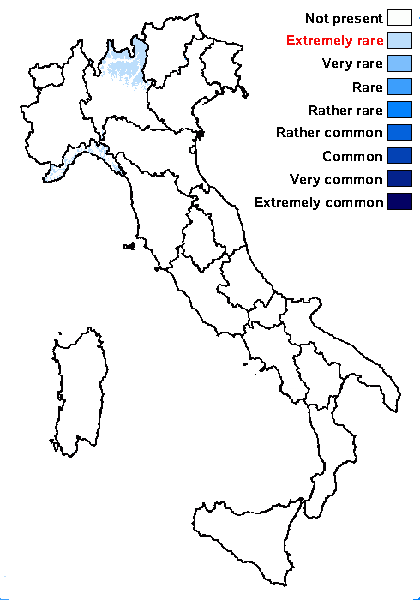Psorotichia frustulosa Anzi
Comm. Soc. Critt. Ital., 2: 4, 1864.
Synonyms: Collemopsis frustulosa (Anzi) Nyl.; Pyrenopsis subolivacea Werner
Distribution: N - Lomb (Schultz 2014), Lig (S-F145650).
Description: Thallus crustose, dark grey to black, c. 100 µm thick, poorly delimited, formed by more or less dispersed, 0.25-0.75 mm wide granules, sometimes poorly developed and inapparent, homoiomerous, pseudoparenchymatous throughout, the hyphae 3-7 µm thick. Apothecia immersed or semi-immersed, 0.08-0.17 mm across, with an initially punctiform, later slightly expanded, concave, dark brown-red disc surrounded by a thin thalline margin. Proper exciple poorly differentiated, up to 5 µm wide, not extending below the hypothecium; epithecium orange-brown, 8-12 µm high; hymenium colourless, 90-120 µm high, I+ blue; paraphyses branched and anastomosing, with cylindrical cells, 1-2.5 µm thick, only slightly constricted at septa; hypothecium colourless, 30-60 µm high. Asci 8-spored, cylindrical-clavate, with a rather thick, not amyloid wall, without apical amyloid thickenings, 40-65 x 10-16 µm. Ascospores 1-celled, hyaline, subglobose and 7–10 x 5–8 μm
or broadly ellipsoid and up to c. 15 x 11 μm. Pycnidia immersed, globose, unilocular, up to 80 µm across. Conidia globose or subglobose, 1-2 x 1-1.5 µm. Photobiont cyanobacterial, chroococcoid (Chroococcidiopsis), of a few cells measuring 3-10 x 3-7 µm, surrounded by a gelatinous sheath which is yellowish brown near the thallus surface. Spot tests: all negative. Chemistry: without lichen substances. Note: on more or less steeply inclined, sunny surfaces of calcareous or basic siliceous rocks with periodical water seepage after rain, sometimes even on Eternit.
Growth form: Crustose
Substrata: rocks
Photobiont: cyanobacteria, coccaceous (e.g. Gloeocapsa)
Reproductive strategy: mainly sexual
On otherwise dry surfaces with short periods of water seepage after rain
Poorly known taxon in need of further study
Commonnes-rarity: (info)
Alpine belt: extremely rare
Subalpine belt: extremely rare
Oromediterranean belt: absent
Montane belt: extremely rare
Submediterranean belt: absent
Padanian area: absent
Humid submediterranean belt: absent
Humid mediterranean belt: extremely rare
Dry mediterranean belt: extremely rare

Predictive model
Growth form: Crustose
Substrata: rocks
Photobiont: cyanobacteria, coccaceous (e.g. Gloeocapsa)
Reproductive strategy: mainly sexual
On otherwise dry surfaces with short periods of water seepage after rain
Poorly known taxon in need of further study
Commonnes-rarity: (info)
Alpine belt: extremely rare
Subalpine belt: extremely rare
Oromediterranean belt: absent
Montane belt: extremely rare
Submediterranean belt: absent
Padanian area: absent
Humid submediterranean belt: absent
Humid mediterranean belt: extremely rare
Dry mediterranean belt: extremely rare

Predictive model
 Index Fungorum
Index Fungorum
 GBIF
GBIF

